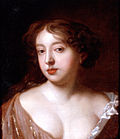Moll Davis

Moll Davis (eigentlich Mary Davis; * 1648 in Westminster; † um 1700 in London) war eine englische Theaterschauspielerin und Kurtisane, sowie die Mätresse von König Karl II. von England.
Leben
Mary „Moll“ Davis war eine populäre Tänzerin, Sängerin und Schauspielerin. Nach einem Theaterbesuch im Jahre 1667 lernte sie den König Karl II. (1630–1685) – er hatte eine Vorliebe für schöne Schauspielerinnen – kennen und wurde seine Geliebte. Aus der Beziehung ging eine Tochter, Lady Mary Tudor (1673–1726), hervor. Durch mehrere kleine Intrigen ihrer Rivalin Nell Gwyn (1650–1687), verließ der König seine Favoritin. Sie erhielt bis zu ihrem Tode eine jährliche Leibrente von £ 1000 und ein Haus in London.
In der Oper Venus and Adonis von John Blow, die erstmals im Sommer 1681 in Oxford vor König Karl II. aufgeführt wurde, spielte die Rolle der Venus Moll Davis. Die Rolle des Cupid wurde von ihrer Tochter Lady Mary Tudor gesungen, die zu dieser Zeit erst neun Jahre alt war.
Galerie
- Peter Lely: Moll Davis, um 1665
- Peter Lely: Moll Davis, um 1665
- Mary Beale: Moll Davis, 1675
Literatur
- Brenda Ralph Lewis: The Mistresses of Charles II.
- Das geheime Tagebuch. Insel Verlag Anton Kippenberg, Leipzig 1980 (hg. von Anselm Schlösser, übertragen von Jutta Schlösser), als Lizenzausgabe erschienen im Insel Verlag, Frankfurt am Main 1982, ISBN 3-458-32337-6
Weblinks
| Personendaten | |
|---|---|
| NAME | Davis, Moll |
| ALTERNATIVNAMEN | Davis, Mary |
| KURZBESCHREIBUNG | englische Schauspielerin und Mätresse von König Karl II. von England |
| GEBURTSDATUM | 1648 |
| GEBURTSORT | Westminster |
| STERBEDATUM | um 1700 |
| STERBEORT | London |






